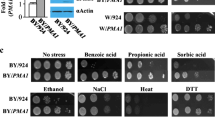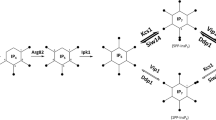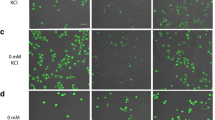Abstract
Saccharomyces cerevisiae contains a family of 17 hexose transporter (HXT) genes; only nine have assigned functions, some of which are still poorly defined. Despite extensive efforts to characterize the hexose transporters, the expression of HXT6 and HXT8-17 remains an enigma. In nature, S. cerevisiae finds itself under extreme nutritional conditions including sugars in excess of 40% (w/v), depletion of nutrients and extremes of both temperature and pH. Using HXT promoter–lacZ fusions, we have identified novel conditions under which the HXT17 gene is expressed; HXT17 promoter activity is up-regulated in media containing raffinose and galactose at pH 7.7 versus pH 4.7. We demonstrated that HXT5, HXT13 and, to a lesser extent, HXT15 were all induced in the presence of non-fermentable carbon sources. HXT1 encodes a low-affinity transporter and in short-term osmotic shock experiments, HXT1 promoter activity was reduced when cells were exposed to media containing 40% glucose. However, we found that the HXT1 mRNA transcript was stabilized under conditions of osmotic stress. Furthermore, the stabilization of HXT1 mRNA does not appear to be gene specific because 30 min after transcriptional arrest there is a fourfold more mRNA in osmotically stressed versus non-stressed yeast cells. A large portion of S. cerevisiae mRNA molecules may, therefore, have a decreased rate of turnover during exposure to osmotic stress indicating that post-transcriptional regulation plays an important role in the adaptation of S. cerevisiae to osmotic stress.







Similar content being viewed by others
References
Ausubel FM (1995) Short protocols in molecular biology: a compendium of methods from current protocols in molecular biology, 3rd edn. Wiley, New York, chapter 13
Bisson LF (1999) Stuck and sluggish fermentations. Am J Enol Vitic 50:107–119
Bisson LF, Coons DM, Kruckeberg AL, Lewis DA (1993) Yeast sugar transporters. Crit Rev Biochem Mol Biol 28:259–308
Blomberg A, Adler L (1992) Physiology of osmotolerance in fungi. Adv Microb Physiol 33:145–212
Boles E, Hollenberg CP (1997) The molecular genetics of hexose transport in yeasts. FEMS Microbiol Rev 21:85–111
Brachmann CB et al (1998) Designer deletion strains derived from Saccharomyces cerevisiae S288C: a useful set of strains and plasmids for PCR-mediated gene disruption and other applications. Yeast 14:115–132
Causton HC et al (2001) Remodeling of yeast genome expression in response to environmental changes. Mol Biol Cell 12:323–337
Diderich JA et al (1999) Glucose uptake kinetics and transcription of HXT genes in chemostat cultures of Saccharomyces cerevisiae. J Biol Chem 274:15350–15359
Diderich JA, Schuurmans JM, Van Gaalen MC, Kruckeberg AL, Van Dam K (2001) Functional analysis of the hexose transporter homologue HXT5 in Saccharomyces cerevisiae. Yeast 18:1515–1524
Erasmus DJ, van der Merwe GK, van Vuuren HJJ (2003) Genome-wide expression analyses: metabolic adaptation of Saccharomyces cerevisiae to high sugar stress. FEMS Yeast Res 3:375–399
Flick KM et al (2003) Grr1-dependent inactivation of Mth1 mediates glucose-induced dissociation of Rgt1 from HXT gene promoters. Mol Biol Cell 14:3230–3241
Gasch AP et al (2000) Genomic expression programs in the response of yeast cells to environmental changes. Mol Biol Cell 11:4241–4257
Gietz RD, Schiestl RH (1995) Transforming yeast with DNA. Methods Mol Cell Biol 5:255–269
Gross C, Kelleher M, Iyer VR, Brown PO, Winge DR (2000) Identification of the copper regulon in Saccharomyces cerevisiae by DNA microarrays. J Biol Chem 275:32310–32316
Hirayama T, Maeda T, Saito H, Shinozaki K (1995) Cloning and characterization of seven cDNAs for hyperosmolarity-responsive (HOR) genes of Saccharomyces cerevisiae. Mol Gen Genet 249:127–138
Hohmann S (2002) Osmotic stress signaling and osmoadaptation in yeasts. Microbiol Mol Biol Rev 66:300–372
Jona G, Choder M, Gileadi O (2000) Glucose starvation induces a drastic reduction in the rates of both transcription and degradation of mRNA in yeast. Biochim Biophys Acta 1491:37–48
Jungmann J et al (1993) Mac1, a nuclear regulatory protein related to Cu-dependent transcription factors is involved in Cu/Fe utilization and stress resistance in yeast. EMBO J 12:5051–5056
Kishore R, McMullen MR, Nagy LE (2001) Stabilization of tumor necrosis factor alpha mRNA by chronic ethanol: role of A + U-rich elements and p38 mitogen-activated protein kinase signaling pathway. J Biol Chem 276:41930–41937
Kishore R, McMullen MR, Cocuzzi E, Nagy LE (2004) Lipopolysaccharide-mediated signal transduction: stabilization of TNF-alpha mRNA contributes to increased lipopolysaccharide-stimulated TNF-alpha production by Kupffer cells after chronic ethanol feeding. Comp Hepatol 3(Suppl 1):S31
Ko CH, Liang H, Gaber RF (1993) Roles of multiple glucose transporters in Saccharomyces cerevisiae. Mol Cell Biol 13:638–648
Kruckeberg AL (1996) The hexose transporter family of Saccharomyces cerevisiae. Arch Microbiol 166:283–292
Kruckeberg AL, Bisson LF (1990) The HXT2 gene of Saccharomyces cerevisiae is required for high-affinity glucose transport. Mol Cell Biol 10:5903–5913
Lafuente MJ, Gancedo C, Jauniaux JC, Gancedo JM (2000) Mth1 receives the signal given by the glucose sensors Snf3 and Rgt2 in Saccharomyces cerevisiae. Mol Microbiol 35:161–172
Lamb TM, Xu W, Diamond A, Mitchell AP (2001) Alkaline response genes of Saccharomyces cerevisiae and their relationship to the RIM101 pathway. J Biol Chem 276:1850–1856
Lewis DA, Bisson LF (1991) The HXT1 gene product of Saccharomyces cerevisiae is a new member of the family of hexose transporters. Mol Cell Biol 11:3804–3813
Li FN, Johnston M (1997) Grr1 of Saccharomyces cerevisiae is connected to the ubiquitin proteolysis machinery through Skp1: coupling glucose sensing to gene expression and the cell cycle. EMBO J 16:5629–5638
Liang H, Gaber R (1996) A novel signal transduction pathway in Saccharomyces cerevisiae defined by Snf3-regulated expression of HXT6. Mol Biol Cell 7:1953–1966
Luyten K, Riou C, Blondin B (2002) The hexose transporters of Saccharomyces cerevisiae play different roles during enological fermentation. Yeast 19:713–726
Maier A, Volker B, Boles E, Fuhrmann GF (2002) Characterisation of glucose transport in Saccharomyces cerevisiae with plasma membrane vesicles (countertransport) and intact cells (initial uptake) with single Hxt1, Hxt2, Hxt3, Hxt4, Hxt6, Hxt7 or Gal2 transporters. FEMS Yeast Res 2:539–550
van der Merwe GK, van Vuuren HJJ, Cooper TG (2001) Cis-acting sites contributing to expression of divergently transcribed DAL1 and DAL4 genes in S. cerevisiae: a word of caution when correlating cis-acting sequences with genome-wide expression analyses. Curr Genet 39:156–165
Miller JH (1972) Experiments in molecular genetics. Cold Spring Harbor Laboratory, Cold Spring Harbor
Mosley AL, Lakshmanan J, Aryal BK, Ozcan S (2003) Glucose-mediated phosphorylation converts the transcription factor Rgt1 from a repressor to an activator. J Biol Chem 278:10322–10327
Nonet M, Scafe C, Sexton J, Young R (1987) Eucaryotic RNA polymerase conditional mutant that rapidly ceases mRNA synthesis. Mol Cell Biol 7:1602–1611
Nourani A, Wesolowski-Louvel M, Delaveau T, Jacq C, Delahodde A (1997) Multiple-drug-resistance phenomenon in the yeast Saccharomyces cerevisiae: involvement of two hexose transporters. Mol Cell Biol 17:5453–5460
Ozcan S, Johnston M (1995) Three different regulatory mechanisms enable yeast hexose transporter (HXT) genes to be induced by different levels of glucose. Mol Cell Biol 15:1564–1572
Ozcan S, Johnston M (1999) Function and regulation of yeast hexose transporters. Microbiol Mol Biol Rev 63:554–569
Ozcan S, Leong T, Johnston M (1996) Rgt1p of Saccharomyces cerevisiae, a key regulator of glucose-induced genes, is both an activator and a repressor of transcription. Mol Cell Biol 16:6419–6426
Posas F, Chambers JR, Heyman JA, Hoeffler JP, de Nadal E, Arino J (2000) The transcriptional response of yeast to saline stress. J Biol Chem 275:17249–17255
Reifenberger E, Freidel K, Ciriacy M (1995) Identification of novel HXT genes in Saccharomyces cerevisiae reveals the impact of individual hexose transporters on glycolytic flux. Mol Microbiol 16:157–167
Reifenberger E, Boles E, Ciriacy M (1997) Kinetic characterization of individual hexose transporters of Saccharomyces cerevisiae and their relation to the triggering mechanisms of glucose repression. Eur J Biochem 245:324–333
Rep M, Albertyn J, Thevelein JM, Prior BA, Hohmann S (1999a) Different signalling pathways contribute to the control of GPD1 gene expression by osmotic stress in Saccharomyces cerevisiae. Microbiology 145:715–727
Rep M et al (1999b) Osmotic stress-induced gene expression in Saccharomyces cerevisiae requires Msn1p and the novel nuclear factor Hot1p. Mol Cell Biol 19:5474–5485
Rep M, Krantz M, Thevelein JM, Hohmann S (2000) The transcriptional response of Saccharomyces cerevisiae to osmotic shock. Hot1p and Msn2p/Msn4p are required for the induction of subsets of high osmolarity glycerol pathway-dependent genes. J Biol Chem 275:8290–8300
Rossignol T, Dulau L, Blondin B (2003) Genome-wide analysis of yeast gene expression during wine fermentation. Yeast 20:S314–S314
Schmidt MC et al (1999) Std1 and Mth1 proteins interact with the glucose sensors to control glucose-regulated gene expression in Saccharomyces cerevisiae. Mol Cell Biol 19:4561–4571
Schulte F, Wieczorke R, Hollenberg CP, Boles E (2000) The HTR1 gene is a dominant negative mutant allele of MTH1 and blocks Snf3- and Rgt2-dependent glucose signaling in yeast. J Bacteriol 182:540–542
Serrano R, Ruiz A, Bernal D, Chambers JR, Arino J (2002) The transcriptional response to alkaline pH in Saccharomyces cerevisiae: evidence for calcium-mediated signalling. Mol Microbiol 46:1319–1333
Serrano R, Bernal D, Simon E, Arino J (2004) Copper and iron are the limiting factors for growth of the yeast Saccharomyces cerevisiae in an alkaline environment. J Biol Chem 279:19698–19704
Theodoris G, Fong NM, Coons DM, Bisson LF (1994) High-copy suppression of glucose transport defects by HXT4 and regulatory elements in the promoters of the HXT genes in Saccharomyces cerevisiae. Genetics 137:957–966
Tomas-Cobos L, Casadome L, Mas G, Sanz P, Posas F (2004) Expression of the HXT1 low-affinity glucose transporter requires the coordinated activities of the HOG and glucose signalling pathways. J Biol Chem 279:22010–22019
Vallier LG, Coons D, Bisson LF, Carlson M (1994) Altered regulatory responses to glucose are associated with a glucose transport defect in grr1 mutants of Saccharomyces cerevisiae. Genetics 136:1279–1285
Verwaal R, Paalman JW, Hogenkamp A, Verkleij AJ, Verrips CT, Boonstra J (2002) HXT5 expression is determined by growth rates in Saccharomyces cerevisiae. Yeast 19:1029–1038
Werner-Washburne M, Braun E, Johnston GC, Singer RA (1993) Stationary-phase in the yeast Saccharomyces cerevisiae. Microbiol Rev 57:383–401
Wieczorke R, Krampe S, Weierstall T, Freidel K, Hollenberg CP, Boles E (1999) Concurrent knock-out of at least 20 transporter genes is required to block uptake of hexoses in Saccharomyces cerevisiae. FEBS Lett 464:123–128
Yale J, Bohnert HJ (2001) Transcript expression in Saccharomyces cerevisiae at high salinity. J Biol Chem 276:15996–16007
Ye L, Berden JA, van Dam K, Kruckeberg AL (2001) Expression and activity of the Hxt7 high-affinity hexose transporter of Saccharomyces cerevisiae. Yeast 18:1257–1267
Acknowledgments
We thank Mark Johnston for providing the HXT–lacZ plasmids, Richard Young for donating the Y260 yeast strain and Russ Morris of the University of British Columbia Media group for preparing artwork. This research was supported by an NSERC grant 217271–99 to HJJVV.
Author information
Authors and Affiliations
Corresponding author
Additional information
Communicated by S. Hohmann
Rights and permissions
About this article
Cite this article
Greatrix, B.W., van Vuuren, H.J.J. Expression of the HXT13, HXT15 and HXT17 genes in Saccharomyces cerevisiae and stabilization of the HXT1 gene transcript by sugar-induced osmotic stress. Curr Genet 49, 205–217 (2006). https://doi.org/10.1007/s00294-005-0046-x
Received:
Revised:
Accepted:
Published:
Issue Date:
DOI: https://doi.org/10.1007/s00294-005-0046-x




